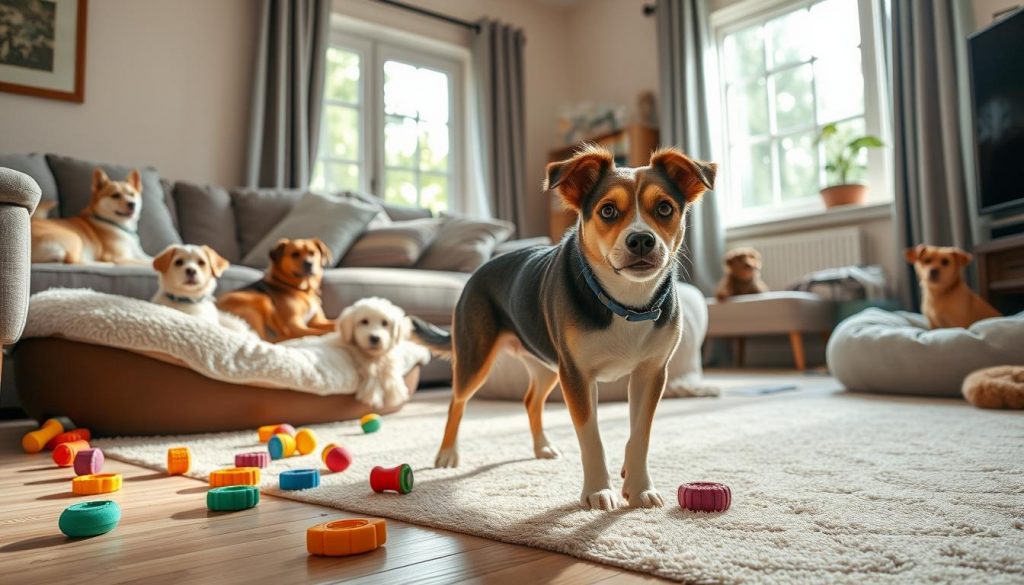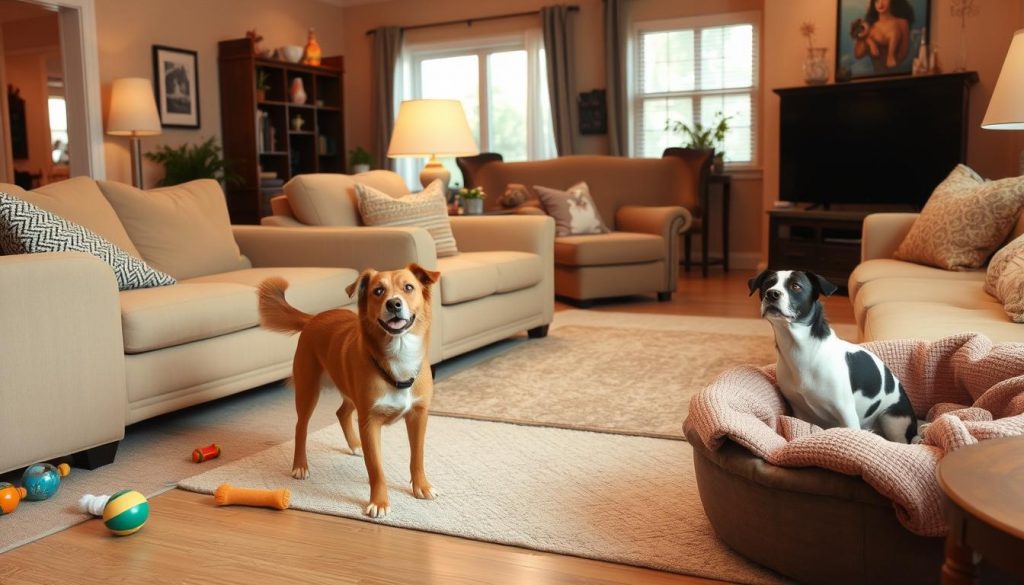Thinking of bringing a new dog home? It can be tough, but with the right steps, it can be a great experience. It’s key to plan and manage the first meetings between your new and existing dogs. This is a big part of making sure everyone gets along.

To welcome a new dog, you need to prepare, be patient, and understand dog behavior. In this article, we’ll help you through the process. We’ll share tips and advice to make the transition smooth for your new dog and existing pets.
Key Takeaways
- Prepare your home and existing pets before introducing a new dog to your home
- Follow dog adoption tips to ensure a smooth transition for your new dog
- Understand canine behavior to manage interactions between your new and existing dogs
- Keep the first meetings between your new and existing dogs calm and controlled
- Provide a safe space for your pets to retreat if needed, which is an essential part of new pet integration
- Monitor body language and signs of aggression during introductions
- Seek professional help if signs of aggression persist during introductions, to ensure a successful new pet integration and dog adoption
Essential Preparation Before You Introduce a New Dog to Your Home
Bringing a new dog home is exciting, but it needs careful planning. You must prepare your home and family for the new dog. This includes setting up a safe space, getting the right supplies, and making house rules.
A quiet room or area is a good safe space for your new dog. You’ll need all the essentials for your dog’s comfort and security. House rules and routines help your dog know what’s expected and feel stable. Important things to consider include:
- Separate feeding areas to prevent squabbles
- Providing safe spaces for each dog to reduce stress levels
- Supervising toys to prevent conflicts
- One-on-one time with owners to provide individual attention
By preparing well, you can make your home welcoming for your new dog. If you face any issues, get advice from a dog behaviorist or trainer.

With the right preparation, your new dog will feel at home. This makes the introduction a positive experience for everyone.
| Preparation Step | Importance |
|---|---|
| Creating a safe space | High |
| Gathering essential supplies | High |
| Establishing house rules and routines | Medium |
The First Day: Step-by-Step Introduction Process
Introducing a new dog to your home needs a careful plan to help prevent behavioural issues like seperation anxiety. It can help ensure a smooth and safe start to your dog’s new life. It’s a key part of pet acclimation strategies to help your new dog settle in. As a canine addition to household, your dog will need time to adjust to its new home. A well-thought-out introduction can greatly help.
First, take your new dog for a walk. This helps them get to know the area and relax. It’s also a chance to see how they react to new things. After the walk, start introducing them to your other pets in a neutral place, like a park or quiet room.
Here are some tips for the introduction:
- Keep the first meeting short and positive
- Watch how your pets act and what they do
- Use scent swapping to introduce them before they meet face-to-face
- Plan where the dog will sleep and eat
The first 30 days are very important for your dog’s new life. By following these steps and using good pet acclimation strategies, your dog can become happy and well-adjusted in your home.
Managing Interactions with Existing Pets
When you bring a new dog home, think about how it will get along with your other pets. It’s important to introduce the dog slowly and watch how pets react to each other. Start by letting them sniff each other from a distance.
Watching how dogs act and what they do is key. If you see any signs of aggression or fear, step in right away. Use treats and praise to teach them to behave well.
Introducing Dogs to Cats and Small Pets
Introducing dogs to cats and small pets needs extra care. These animals can get stressed easily. Keep the first meeting short and watch them closely.
Make sure your new dog has a safe place to go when it feels overwhelmed. This helps keep everyone calm and happy.
By following these tips, you can make a happy home for all your pets. Always praise good behavior and give attention to all pets. Never push pets to be friends if they don’t want to. With patience and love, your new dog will be a beloved family member.
| Pet | Introduction Tips |
|---|---|
| Dogs | Start with a slow introduction, monitor behavior and body language |
| Cats | Keep initial introduction brief and supervised, provide a safe space for the cat |
| Small Pets | Handle with care, keep introduction brief and supervised, provide a safe space for the small pet |
Conclusion: Supporting Your New Dog’s Long-Term Integration
Bringing a new dog home is just the start of a wonderful journey. To help your new dog settle in well, keep giving them support and watch over them. Make sure to watch how they get along with other pets. It might take a year for them to really feel part of the family.
Keep things the same every day, with time for each dog to play alone and walk together. Feed them separately at first, then let them eat together when they’re ready. Teach them to listen to you and set clear rules. Remember, it’s normal for things to get tough, so stay calm and keep things consistent.
By following this guide, you can make a happy home for all your dogs. Welcoming a new dog takes patience and effort, but it’s all worth it for a joyful family. Enjoy this new time with your pets and watch them grow together.


